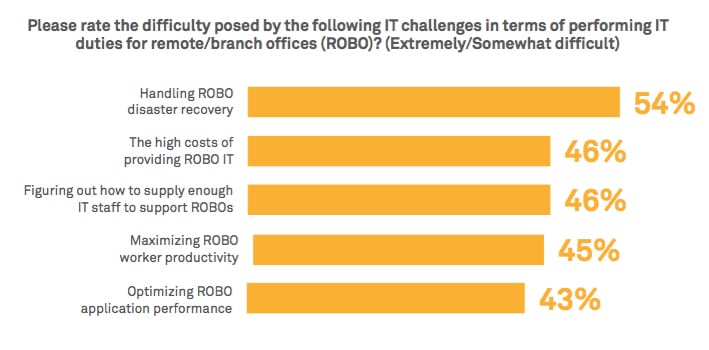 Riverbed has released the results of a new study today, revealing insights around core challenges when it comes to managing IT at the edge, in remote and branch offices (ROBO). While an enterprise's data center has traditionally been the center of IT activities, more organizations are moving to a geographically distributed model for a variety of reasons to support their operations. But expanding IT services at the edge introduces a host of new problems as organizations cope with complexity, cost and security issues that are often harder to manage in a distributed environment.
Riverbed has released the results of a new study today, revealing insights around core challenges when it comes to managing IT at the edge, in remote and branch offices (ROBO). While an enterprise's data center has traditionally been the center of IT activities, more organizations are moving to a geographically distributed model for a variety of reasons to support their operations. But expanding IT services at the edge introduces a host of new problems as organizations cope with complexity, cost and security issues that are often harder to manage in a distributed environment.
Riverbed has released the results of a new study today, revealing insights around core challenges when it comes to managing IT at the edge, in remote and branch offices (ROBO). While an enterprise's data center has traditionally been the center of IT activities, more organizations are moving to a geographically distributed model for a variety of reasons to support their operations. But expanding IT services at the edge introduces a host of new problems as organizations cope with complexity, cost and security issues that are often harder to manage in a distributed environment.
The survey data includes responses from attendees of EMC World, which took place in May of this year. Riverbed found the respondents falling into two distinct groups. 26% of the respondents work at organizations of fewer than 500 people, 42% in an organization of 500-10,000 and the rest (32%) worked at an organization with over 10,000 employees. In total, 93% had reasonability for storage and 72% had responsibility for virtualization.
Interestingly the data collected indicated ROBO is very important to the larger IT organization, coming in behind just the core data center in order of importance; cloud and mobile followed at third and fourth respectively. Managing ROBO is altogether different from the data center though, respondents largely indicated they had their "hands full" in terms of supporting the edge. Specifically they pointed to the following problems:
- Provisioning of infrastructure, applications and services
- Delays in recovering form outages
- IT staff time spent managing ROBO backups

Much of the concern centers around backup and recovery and it doesn't appear organizations plan to sit still. 75% rated the idea of consolidating ROBO data back into the data center or into the cloud as "extremely/somewhat desirable." There are of course many ways to accomplish this goal, but there's also as much angst as there are solutions. For their part, Riverbed has their own ideas around how to solve these edge issues, primary with their SteelFusion product.
SteelFusion is built specifically to address the concern of ROBO IT management. SteelFusion is the first hyperconverged infrastructure built for the purpose of efficient management of ROBO IT. ROBO can present difficulties such as those listed above but SteelFusion aims to tackle these difficulties by extending the power, security, and efficiency of the data center to the branch office. ROBO data is consolidated into the data center, which address several issues found in the survey including the need to provision infrastructure and the lack of IT at a ROBO site. ROBO sites only need a SteelFusion appliance at site, once it is hooked up and powered on, SteelFusion uses FusionSync to sync up to the data center.
SteelFusion can increase performance by providing local compute and optimizing data center access. Users could experience LAN-like performance regardless of the physical location of the ROBO site as it relates to the data center. Delays from recovering loss data or the delay form the resulting data migration after a loss is another worry, one that can directly affect revenue. With SteelFusion not only is the data more secure in the data center but rapid provisioning is supported to recover faster from outages.
StorageReview Podcast with Riverbed
Sign up for the StorageReview newsletter
